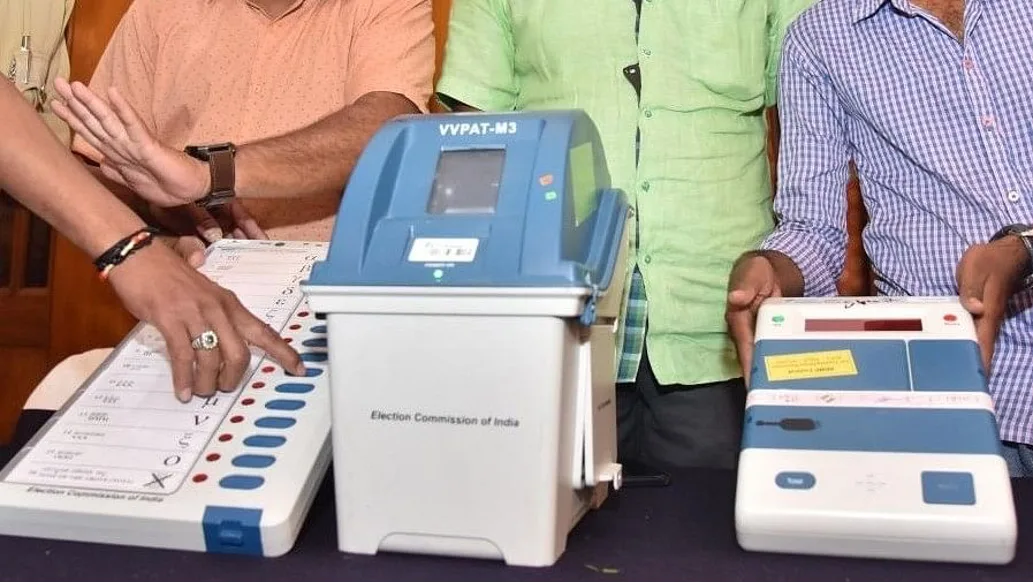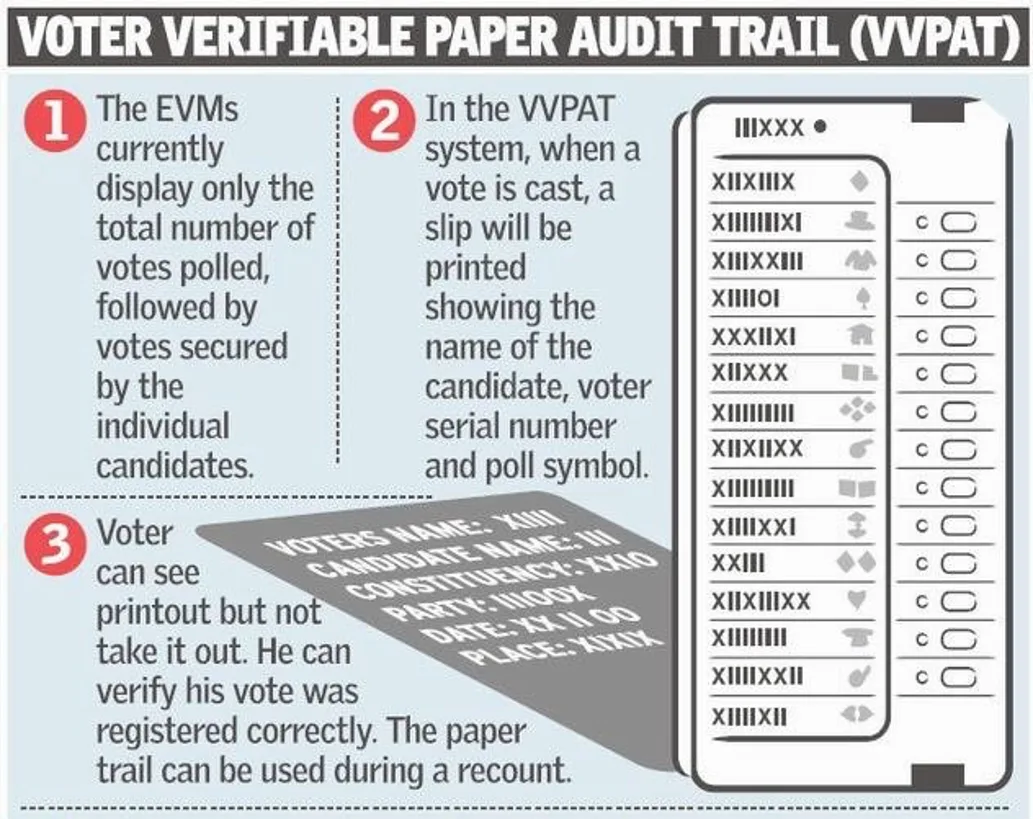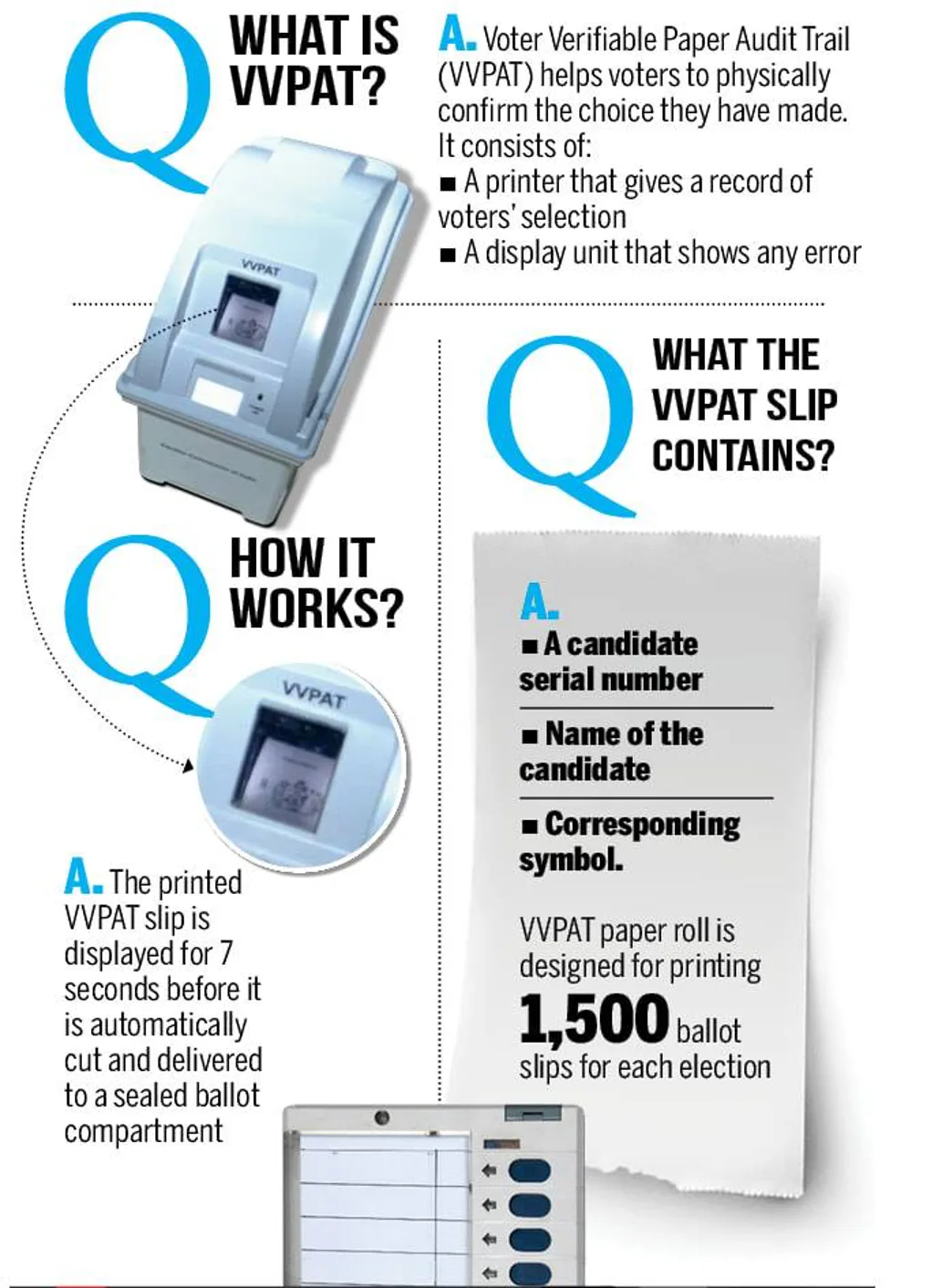What’s in this Article?
- Table of Contents
- Why in the News?
- What exactly is a VVPAT?
- How does the VVPAT work?
- What is an EVM – Electronic Voting Machine?
- Pros & Cons of EVM (Electronic Voting Machines)
- Judicial Pronouncements on Use of EVMs
- Interesting Facts about VVPAT
- Present VVPAT Slip Counting Protocol
- Challenges Related to EVM and VVPAT Systems
- Suggestions to Make VVPAT More Transparent
- Criticism against the Election Commission (EC)
- Conclusion
- FAQs
- MCQs
Why in the News?
- The Supreme Court on Tuesday listed for April 16 a batch of PILs seeking a direction to the Election Commission of India (ECI) to ensure a mandatory match of VVPAT slips with the votes cast in the EVMs.
- Though the matter was supposed to be heard on April 16, on Tuesday it was listed before a bench of Justice Sanjiv Khanna and Justice Dipankar Datta.
- As soon as the matter came up for hearing, Justice Khanna expressed surprise at how it got listed for Tuesday though it was indicated at the earlier hearing on April 3 that it would be heard on April 16 as top of the board matter.
- On April 1, another bench headed by Justice B.R. Gavai sought responses from the Centre and the ECI on a PIL seeking “complete count” of VVPAT (Voter Verifiable Paper Audit Trail) slips in elections as opposed to the current practice of verification of only five randomly selected EVMs (electronic voting machines) through VVPAT paper slips.
What exactly is a VVPAT?
- VVPAT, short for Voter Verifiable Paper Audit Trail, serves as a method of providing feedback to voters through electronic voting machines (EVMs).
- It ensures that a voter’s choice is accurately recorded by the system.
- VVPAT machines act independently to verify votes, allowing voters to confirm their selections and enabling an audit of the electronic results.
- This includes displaying the candidate’s name and their associated party symbol.
There has been significant demand from political parties for the integration of VVPATs during elections, citing concerns over the complete security and tamper-proof nature of EVMs.
How does the VVPAT work?
- Step 1: In India, voters use an Electronic Voting Machine (EVM). EVM is made up of two parts: a control unit and a balloting unit.
- The machine’s balloting unit has a list of candidate names, party emblems, and a blue button.
- The voter can vote by pressing the button next to the candidate’s name.
- Step 2: When a voter casts a vote on an EVM, a printer-like VVPAT apparatus comes into picture.
- VVPAT is generally connected to the EVM and it generates a slip with the candidate’s serial number, name, and symbol.
- The voter can use this slip to double-check his vote. Before being mechanically cut, this VVPAT slip is displayed for 7 seconds.
- After seeing the slip, it is cut and deposited into the VVPAT machine’s dropbox, which results in a beep.
Election officers can only use the VVPAT machines in the most extreme of circumstances.
What is an EVM – Electronic Voting Machine?
- Design: The setup consists of two components: the control unit and the balloting unit, connected via a cable. The control unit is held by the presiding officer, while the balloting unit is placed in the voting compartment for electors to cast their votes.
- History: Initially tested during the 1982 Kerala elections on a trial basis, the Electronic Voting Machine (EVM) was later utilized comprehensively in the 2004 Lok Sabha elections.
- All state elections and by-elections used EVMs by
- Legal Authorization: Section 61A was incorporated into the Representation of the People Act 1951, granting authority to the Election Commission of India (ECI) regarding the use of EVMs.
- Development: Developed by the Technical Experts Committee (TEC) of Election Commission, with Bharat Electronics Ltd, Bangalore, and Electronic Corporation of India Ltd, Hyderabad.
Pros & Cons of EVM (Electronic Voting Machines)
- Pros of Electronic Voting Machines (EVMs):
- Accuracy: EVMs are designed to minimize errors in the voting process, reducing the chances of invalid or miscounted votes.
- Efficiency: EVMs streamline the voting process, allowing for quicker tabulation of results compared to traditional paper-based methods.
- Reduced Fraud: EVMs help to mitigate the risks associated with ballot tampering, impersonation, and other forms of electoral fraud.
- Cost-effective: Over time, EVMs can be more economical than traditional paper ballots due to reduced printing and storage costs.
- Accessibility: EVMs often feature user-friendly interfaces and can be adapted to accommodate voters with disabilities, improving accessibility and inclusivity in elections.
- Cons of Electronic Voting Machines (EVMs):
- Security Concerns: Despite efforts to secure EVMs, concerns persist about the possibility of hacking or manipulation, potentially undermining the integrity of elections.
- Lack of Transparency: EVMs operate using proprietary technology, making it difficult for independent observers and experts to verify the accuracy and security of the voting process.
- Reliability Issues: EVMs may encounter technical glitches or malfunctions, leading to disruptions in the voting process and undermining public trust in the electoral system.
- Digital Divide: In regions with limited access to technology or inadequate infrastructure, reliance on EVMs may exacerbate disparities in voting access and disenfranchise certain segments of the population.
- Vulnerability to Malfunction: EVMs rely on electronic components that can be susceptible to malfunctions, power outages, or environmental factors, potentially compromising the integrity of the voting process.
Judicial Pronouncements on Use of EVMs
- People’s Union for Civil Liberties v. Union of India, (2013): NOTA option included in the EVMs to enable the voters to exercise their right of not to vote while maintaining their right of secrecy.
- Subramanian Swamy v. Election Commission of India, (2013): Supreme Court held that “paper trail” is an indispensable requirement of free and fair elections paving the way for the introduction of VVPAT
- Chandrababu Naidu v. Union of India, (2019): The SC held that 5 VVPAT per Assembly Constituency or Assembly Segments in a Parliamentary Constituency would be verified manually.
Interesting Facts about VVPAT
- VVPAT slip is displayed for 7 seconds before it’s automatically cut and falls in the sealed drop box of the VVPAT.
- In general, To count the vote of one VVPAT it takes one hour.
- The VVPAT were first deployed in the bye-election for the Noksen Assembly seat in Tuensang district of Nagaland in September
- VVPAT consists of a Printer and a VVPAT Status Display Unit (VSDU).
- Each EVM records up to 2,000
- Operates without electricity, powered by battery from Bharat Electronics Ltd/Electronic Corporation of India.
- Uses one-time programmable/masked chip for security.
- Stand-alone machines without an operating system for enhanced security.
Present VVPAT Slip Counting Protocol
- In 2018, the ECI sought advice from the Indian Statistical Institute (ISI) to establish an effective sample size for verifying VVPAT slips.
- Originally, only one randomly chosen polling station per Assembly constituency had its VVPAT slips counted.
- Following a Supreme Court ruling in 2019, this was increased to five polling stations per Assembly seat.
- The ISI recommended examining VVPAT slips from 479 EVMs to ensure a high level of confidence that the proportion of faulty EVMs is below 2%.
- Recent VVPAT-related Petitions
- Opposition parties advocate for increased VVPAT verification, varying from 50% to 100%, to enhance electoral transparency and preserve the integrity of democratic procedures.
- However, the Election Commission stresses the importance of striking a balance between transparency and practical constraints, pointing out logistical hurdles and potential delays in announcing results.
Challenges Related to EVM and VVPAT Systems
- Potential Vulnerabilities: The integration of VVPATs has introduced potential vulnerabilities that were absent in the previous standalone EVM setup, despite the presence of technical and administrative safeguards in the older system.
- Minor Discrepancies: The examination of VVPATs during the 2019 general election and various Assembly elections has revealed that any disparities between the VVPAT recount and the EVM count have been negligible.
- Persistent Critics of VVPATs: Despite the implementation of a process where VVPAT tallies from five random polling booths in each Assembly constituency are cross-checked with the EVM vote count, skeptics of EVM usage in Indian elections remain unconvinced.
- While concerns regarding malpractices and EVM manipulation persist, there has been no substantiated evidence of actual tampering with EVMs thus far.
Suggestions to Make VVPAT More Transparent
- Machine Audit: The system maintains a comprehensive record of all executed commands, extending beyond the recorded votes in the EVM’s ballot unit and the printed slips in the VVPATs, facilitating an audit to detect any potential malicious code.
- Upgrading Existing Machines: This could indeed enhance the system’s resilience and be viewed as an improvement to the current machines.
- Ensure Complete Transparency: Opting for a 100% recount of all VVPATs would ensure full transparency, rather than the current method of sampling for recounts.
- Increase in Recounting Samples: Enhancing the recount sample size to achieve greater statistical significance, by tailoring the selected number of Assemblies specific to each State/Union Territory according to the size of the region.
- Increase the recount sample in seats with narrow victory margins (e.g., less than 1% of the total votes cast).
Criticism against the Election Commission (EC)
- The Electoral Commission (EC) has failed to notify political parties regarding the detection of 650,000 faulty VVPAT machines.
- This number surpasses one-third (37%) of the total machines utilized in the 2019 Lok Sabha election, potentially impacting voters in the previous general election and subsequent Assembly polls.
- Numerous VVPATs with consecutive serial numbers across various batches from different manufacturers have been discovered as defective. These defects are severe enough that the machines have been returned to their manufacturers.
- The EC neglected to adhere to its own standard operating procedures, outlined in the Model Code of Conduct, which necessitate field officers to identify defects and report any issues within seven days.
- To regain public confidence in the electoral process, the EC must prioritize transparency.
Conclusion
- In conclusion, the recent incidents concerning Electronic Voting Machines (EVMs) and Voter Verifiable Paper Audit Trail (VVPAT) machines underscore the critical importance of transparency, accountability, and adherence to established protocols in electoral processes.
- Elections in India will be conducted with paper trail which will ensure that EVMs are not hacked or tampered. This can avoid disastrous effects in the case of the UN, EU or any other international election.
- The detection of a significant number of defective VVPAT machines raises serious concerns about the integrity of past elections and the potential impact on voter confidence.
- It is imperative for electoral authorities to address these issues promptly and comprehensively, restoring public faith in the electoral process.
- Additionally, efforts should be made to enhance the robustness of EVMs and VVPATs, ensuring their reliability and accuracy in future elections.
- Only through transparent procedures, rigorous oversight, and proactive measures can the credibility of electronic voting systems be safeguarded, thereby upholding the fundamental principles of democracy.
Disclaimer: The article may contain information pertaining to prior academic years; for further information, visit the exam’s “official or concerned website“.
Frequently Asked Questions (FAQ’s)
Q. What is the use of electronic voting machines?
- Electronic voting machines are an electronic way to vote and count votes in an election.
Q. Who manufactures electronic voting machines?
- EVMs in India are manufactured by Bharat Electronics Ltd (Bengaluru) and Electronic Corporation of India Ltd (Hyderabad).
Q. What is NOTA?
- NOTA is an option in voting machines in India. Since 2009, most elections in India have given voters the option to select “None of the Above” (or NOTA).
- The vote has no electoral significance; even if a majority of ballots are cast, the winner would be the one who received the largest proportion of the vote.
Q. What will happen if the EVM in a particular polling station goes out of order?
- In such a scenario, the EVM will be replaced with a new one. The votes counted till then is safe in the memory of the control unit.
Q. When was the EVM first introduced in elections?
- EVMs were used for the first time in India in 1982 in the by-election to the North Paravur Assembly constituency in Kerala.
Q. In which countries is EVM banned?
- Some countries that have discontinued using the EVMs are the Netherlands, Kazakhstan and Ireland.
Q. How can EVMs be used in areas where there is no electricity?
- EVMs do not need electricity, they run on batteries.
Q. Is it mandatory to vote?
- As per the law, no one is required to vote on a compulsory basis. Rather voting is a right entitled to a citizen of the nation.
MCQ’s
Q. Who was the first woman to become the Chief Election Commissioner of India?
- Mrinalini Sarabhai
- V S Ramadevi
- Sarojini Naidu
- None of the above
Ans: (b) Mrinalini Sarabhai
Q. Who was the first Chief Election Commissioner of India?
- Sukumar Sen
- V V Giri
- Mukul Rohtagi
- None of the above
Ans: (a) Sukumar Sen
Q. With reference to the Constitution of India, prohibition or limitations or provisions contained in ordinary laws cannot act as prohibitions or limitations on the constitutional powers under Article 142. It could mean which one of the following?
- The decisions taken by the Election Commission of India while discharging its duties cannot be challenged in any court of law.
- The Supreme Court of India is not constrained in the exercise of its powers by laws made by the Parliament.
- In the event of grave financial crisis in the country, the President of India can declare Financial Emergency without the counsel from the Cabinet.
- State Legislatures cannot make laws on certain matters without the concurrence of Union Legislature
Ans: (b)
Q. In the context of voter-verifiable paper audit trail (VVPAT) slips in elections, consider the following statements:
- VVPAT is a printer that connects to electronic voting machines (EVMs).
- When a person votes electronically, a paper slip is printed for the voter to carry with them.
- It provides voters the opportunity to confirm that their vote was cast accurately and also offers a paper trail for auditing needs.
Select the correct answer using the codes given below:
- 1 only
- 3 only
- 1 and 3 only
- 1, 2 and 3
Ans: c
Explore our courses: https://apnipathshala.com/courses/
Explore Our test Series: https://tests.apnipathshala.com/













